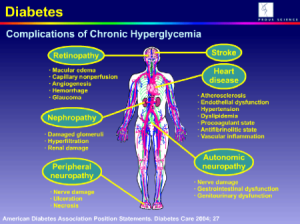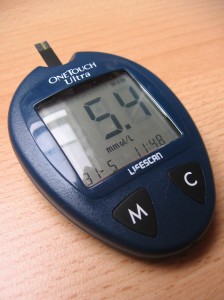This article contains affiliate links. If you make a purchase after clicking on a link I may earn a small commission at no extra cost to you.
The cause of Hypoglycemia is very much gut related, similar to various allergies.
The excess consumption of high carbohydrate food, ironically, causes hypoglycemia.
The exact progress of events is as follows:
1 Consumption of excess sugary food.
2 Raises the blood sugar level too fast. The body responds by releasing insulin and other glucose-regulating hormones from the adrenal gland.
3 Lowers blood sugar, but usually too fast. There is overcompensation and the level falls too low.
4 Sets up symptoms, including hunger. There is a craving for more sweet food, soon after the previous meal.
5 New intake sets off the above cycle all over again. Blood sugar levels roller-coaster up and down many times a day.
6 Eventually the body’s ability to cope with these continuous rushes of sugar become exhausted. The adrenal (stress) gland cannot cope with the demand for glycogen-to-glucose conversion mediated via its hormones, and so the regulation mechanism breaks down completely.
7 The only thing which remains to maintain blood sugar is to keep eating carbohydrate food: it’s a trap!
It is very likely that this condition is pre-diabetic.
After many years, possibly decades, of this sort of abuse the insulin-release mechanism fails completely. The pancreas gland becomes exhausted and is no longer capable of producing this essential hormone.
Hypoglycaemia is the warning sign that trouble is just around the corner.
From the above you will see that sugar is actually the cause of hypoglycaemia.
Sweet foods only seem to give you energy: they appear to do so simply because they took away your pep in the first place.
The worst possible treatment for this condition is sugar, and yet most doctors, through ignorance of the facts, advocate sugary food and sweets to provide a pick-me-up.
Typical hypoglycaemia sufferers eat a poor breakfast, such as coffee and toast, or none at all.
By mid-morning they need a snack — usually cake,biscuits or sweetened drinks — and this triggers hypoglycaemia in a matter of ten to sixty minutes.
The demand is set up for more food, and this continues all day. The diet as a whole is often nutritionally inadequate, lacking in protein foods, especially fats and essential oils. Eating between meals is usual and compulsive, due to cravings. Allergy patients will recognise the strong resemblance between this condition and cravings due to addiction.
Diagnoses of Hypoglycemia
Any doctor should be able to diagnose this condition purely on the basis of the patient’s history: it is glaringly obvious to those who know what to look for.
It is also possible to make a `therapeutic’ diagnosis, that is to treat the condition as if it existed and then if that cures it to assume you were right in the first place.
THE SIX-HOUR GLUCOSE TOLERANCE TEST
The Glucose Tolerance Test (GTT).
The patient fasts overnight, and a blood sample is taken to measure the blood sugar level at this point.
Then the patient is asked to drink a concentrated solution of glucose containing fifty to a hundred grams according to body weight. Repeat blood samples are taken every half-hour, and in each case the blood glucose concentration is measured. In hospital, a period of two-and-a-half hours is allowed in which time it is usually possible to detect a diabetic response, but this is not long enough when hypoglycaemia is suspected; consequently the diagnosis is often missed, even when a GTT is done.
It is better to continue the test for six hours because often the characteristic reaction takes place long after the two-and-a-half hour mark.
The results of a GTT are usually represented graphically, and three typical responses are shown below:
A normal response: – Note that the blood glucose started with a sharp rise to over 50 per cent of the starting value within one hour. Then it fell steadily, but at no stage did it fall below the fasting level, which is taken as the baseline.
A diabetic curve
6 Hours
This is included for interest only. The characteristic of a diabetic curve is that it goes high and stays high, falling only very sluggishly, for the reason that the body has lost the ability to deal with carbohydrate, which is not removed easily from the blood. The test is built around a fast: apart from the test dose the patient had nothing by mouth for almost twenty hours. You will readily see that regular eating will result in a permanently high blood sugar level, which is what diabetes is in essence.
A hypoglycaemia curve
The points to notice about the following example, which came from a fourteen-year old epileptic girl, are as follows. The graph rose as it should during the first hour and appeared to be normal until the third hour, when it suddenly fell very steeply. Within an hour it had dropped by over seventy units; moreover, from then onwards it remained below the fasting level for a considerable time before returning to ‘baseline’.
There are several possible responses which would suggest hypoglycaemia, either actual or latent. Dr Patrick Kingsley, an experienced clinical ecologist practising in Leicestershire, suggests the following criteria for diagnosing hypoglycaemia.
DIAGNOSIS OF HYPOGLYCAEMIA FROM GTT RESULTS
Hypoglycaemia is indicated:
1 When the blood sugar, in the course of a six-hour glucose tolerance test, fails to rise more than 50 per cent above the fasting level (this is rarely encountered);
2 By a glucose curve which falls during a six-hour test to 20 per cent below the fasting level;
3 By a glucose test in which the blood sugar falls fifty milligrams per cent or more during any one hour of the test (usually follows a rapid rise of fifty milligrams per cent in the first thirty minutes);
4 By a glucose tolerance test in which the absolute blood sugar level falls in the range of fifty milligrams per cent or lower (anything below sixty-five milligrams per cent is suspicious);
For further information regarding allergies or intolerance please refer to our home page and peruse all the categories of posts providing information. Alternatively if you have a story to tell regarding your own condition and you wish to share please contact us.
